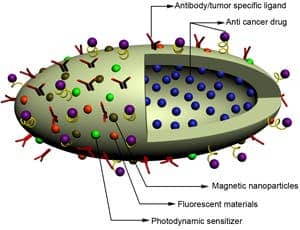Researchers at University of Cincinnati have developed an unique all-in-one nanostructure: it can both diagnose cancer cells and deliver its drug payload for treatment at the same time. Other nano carriers are typically built to serve one of the two purposes, not both at once.
To achieve this, the researchers fashioned a double-sided surface, called a Janus surface, which serves in cancer cell detection, while wrapping anti-cancer drugs in a porous interior. The nano carrier will be useful for:
- Transport cancer-specific detection nanoparticles and biomarkers to a site within the body, e.g., the breast or the prostate. This promises earlier diagnosis than is possible with today’s tools.
- Attach fluorescent marker materials to illuminate specific cancer cells, so that they are easier to locate and find for treatment, whether drug delivery or surgery.
- Deliver anti-cancer drugs for pinpoint targeted treatment of cancer cells, which should result in few drug side effects. Currently, a cancer treatment like chemotherapy affects not only cancer cells but healthy cells as well, leading to serious and often debilitating side effects.

The Janus nanocomponent, on the other hand, has functionally and chemically distinct surfaces to allow it to carry multiple components in a single assembly and function in an intelligent manner.
“In this effort, we’re using existing basic nano systems, such as carbon nanotubes, graphene, iron oxides, silica, quantum dots and polymeric nano materials in order to create an all-in-one, multidimensional and stable nano carrier that will provide imaging, cell targeting, drug storage and intelligent, controlled drug release,” said Donglu Shi, professor of materials science and engineering at UC’s College of Engineering and Applied Science (CEAS, adding that the nano carrier’s promise is currently greatest for cancers that are close to the body’s surface, such as breast and prostate cancer.
As far as I know, anti-cancer nano carriers have yet to enter clinical trials on humans and this might actually take a while. If ultimately found effective, though, structures will provide earlier, faster and more accurate diagnosis at lower cost than today’s technology. Also, because of their targeted drug delivery, this would mean the torments of chemo might finally come to an end.
This research, titled “Dual Surface Functionalized Janus Nanocomposites of Polystyrene//Fe304@Si02 for Simultaneous Tumor Cell Targeting and pH-Triggered Drug Release,” will be presented as an invited talk on Oct. 30, 2013, at the annual Materials Science & Technology Conference in Montreal, Canada.


